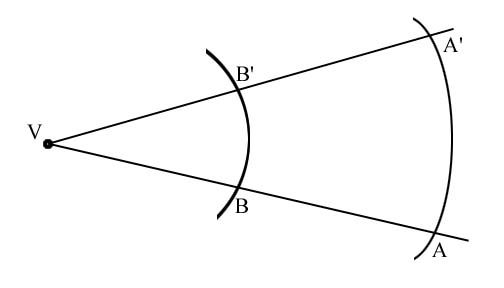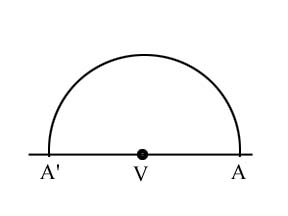THE RADIAN MEASURE OF AN ANGLE
The following discussion includes some paper and pencil exercises which will help you to understand the radian measure of an angle. You will need a compass, a protractor, and a flexible ruler (one that can bend to allow you to measure the length of an arc).
We are familiar with the use of a degree to measure an angle. The degree is defined by dividing the complete circle into 360 equal parts, and calling each part one degree. The choice of the number 360 is entirely arbitrary; there is no particular reason to choose 360 rather than another number that might be convenient. For example, we choose to divide the meter into 100 parts, called centimeters, and the day into 24 parts, called hours.
Another unit, called the radian is less arbitrary, in that it is derived naturally from the geometry of the circle. It also simplifies certain useful mathematical relationships, as we will see.
Begin by drawing an acute angle on a sheet of paper; let the vertex be point V.
 Now with the compass opened as far as possible, place the point on the vertex, and draw an arc of a circle, that intersects the two sides of the angle (at points A and A'). With the flexible ruler, measure (in centimeters) the arclength from A to A'. Also measure the distance VA (the same as VA'), which is the radius of the circle. Record these in a small table which will have three columns: arclength, radius, and the ratio: arclength/radius.
Now with the compass opened as far as possible, place the point on the vertex, and draw an arc of a circle, that intersects the two sides of the angle (at points A and A'). With the flexible ruler, measure (in centimeters) the arclength from A to A'. Also measure the distance VA (the same as VA'), which is the radius of the circle. Record these in a small table which will have three columns: arclength, radius, and the ratio: arclength/radius.
Now use a smaller radius, but with the point of the compass still on V, and draw another arc of a circle; this one intersects the sides of the angle at B and B'. Again record the arclength, the radius, and the ratio. You should find that the ratio is the same for both arcs. [Allow a little difference because of small inaccuracies in your measurement, and round-off error.] Try a third arc, constructed in the same way.
Since these ratios are the same for all different radii of the circles, we can conclude that the ratio of arclength to radius is a property of the angle. It is called the "radian measure of the angle", or just "radian". Note that the radian is a dimensionless quantity, since it is a ratio of two lengths. If you had measured your lengths in inches rather than centimeters, you would get different numbers for the arclength and radius, but the radian would be the same.
Now draw another acute angle, not too similar to the first angle. In the same way, draw an arc from one side of the angle to the other, and measure the arclength, the radius, and calculate the radian. Here you might do just one arc, since we know the radian will come out the same for different radii. You won't be surprised to find that whichever angle is larger has the larger radian measure.
Now measure both angles in degrees with your protractor. We'll want to show that the radian measure of the angle is proportional to the measure of the angle in degrees. To do this convincingly, repeat your construction for a third angle. You'll want three angles fairly evenly spaced between 0 and 90 degrees. Make a little table recording the measure of each angle in degrees and in radians.
Plot a small graph with angle in degrees on the vertical axis, and angle in radians on the horizontal axis. The points should fall on a straight line going through the origin. Draw a straight line fit as close to the three points as possible; find the slope of the line. You should get a value around 57 -- this would be 57 degrees per radian. In other words, one radian is equal to about 57 degrees. Check this by drawing a vertical line going through the point on the horizontal axis that corresponds to 1 radian. Where does this vertical line intersect the straight line of your graph? It should be at about 57 degrees.
The fact that the radian measure is proportional to the angle in degrees is equivalent to a theorem of Euclidean geometry which says that, in a given circle, the arclength cut off by an angle at the center is proportional to the angle.
Where does the "57" come from? To be more precise, let's write the relation between degrees and radians as an equation:
| angle in degrees = constant X angle in radians | Equ. (1) |
The constant is the same for all angles. Therefore, we can evaluate the constant by using a particular angle for which we know the radian measure: Consider a "straight angle", i.e. an angle of 180 degrees.
 In the figure we've drawn the arc from A to A'. But the arc AA' is a semicircle, and we know its length. Since the circumference of a circle is 2pR (where R is the radius), the length of this semicircle is just pR. The radian measure of this angle is therefore equal to
In the figure we've drawn the arc from A to A'. But the arc AA' is a semicircle, and we know its length. Since the circumference of a circle is 2pR (where R is the radius), the length of this semicircle is just pR. The radian measure of this angle is therefore equal to
arclength/radius = pR/R = p.
So an angle of 180 degrees has a radian measure of p. Putting these two values into Equ. (1) above, we find
180 = constant X p, or
constant = 180/p.
The constant relating radians to degrees is 180/p. This is, to 4 significant figures, is 57.30 degrees/radian. Alternately, 1 radian = 57.30 degrees; one degree = 0.01745 radians.
The table below gives values for a few angles:
| Degrees | Radians |
| 360 | 2p |
| 180 | p |
| 114.6 | 2.00 |
| 90 | p/2 = 1.571 |
| 60 | p/3 = 1.047 |
| 57.30 | 1.00 |
| 45 | p/4 = 0.785 |
| 30 | p/6 = 0.524 |
| 28.65 | 0.500 |
| 20 | 0.349 |
Make sure that you can verify these values.
Most scientific calculators have a button that converts degrees to radians, or radians to degrees.
 Now with the compass opened as far as possible, place the point on the vertex, and draw an arc of a circle, that intersects the two sides of the angle (at points A and A'). With the flexible ruler, measure (in centimeters) the arclength from A to A'. Also measure the distance VA (the same as VA'), which is the radius of the circle. Record these in a small table which will have three columns: arclength, radius, and the ratio: arclength/radius.
Now with the compass opened as far as possible, place the point on the vertex, and draw an arc of a circle, that intersects the two sides of the angle (at points A and A'). With the flexible ruler, measure (in centimeters) the arclength from A to A'. Also measure the distance VA (the same as VA'), which is the radius of the circle. Record these in a small table which will have three columns: arclength, radius, and the ratio: arclength/radius. In the figure we've drawn the arc from A to A'. But the arc AA' is a semicircle, and we know its length. Since the circumference of a circle is 2pR (where R is the radius), the length of this semicircle is just pR. The radian measure of this angle is therefore equal to
In the figure we've drawn the arc from A to A'. But the arc AA' is a semicircle, and we know its length. Since the circumference of a circle is 2pR (where R is the radius), the length of this semicircle is just pR. The radian measure of this angle is therefore equal to